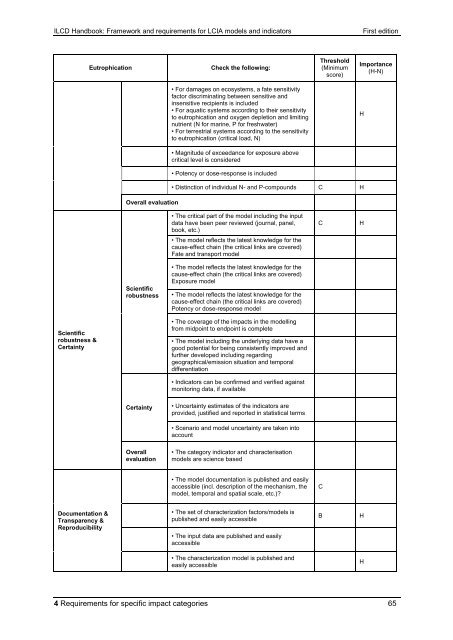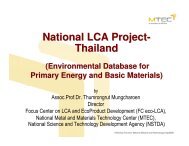ILCD Handbook: Framework and requirements for LCIA models and ...
ILCD Handbook: Framework and requirements for LCIA models and ...
ILCD Handbook: Framework and requirements for LCIA models and ...
Create successful ePaper yourself
Turn your PDF publications into a flip-book with our unique Google optimized e-Paper software.
<strong>ILCD</strong> <strong>H<strong>and</strong>book</strong>: <strong>Framework</strong> <strong>and</strong> <strong>requirements</strong> <strong>for</strong> <strong>LCIA</strong> <strong>models</strong> <strong>and</strong> indicators First edition<br />
Scientific<br />
robustness &<br />
Certainty<br />
Documentation &<br />
Transparency &<br />
Reproducibility<br />
Eutrophication Check the following:<br />
Overall evaluation<br />
Scientific<br />
robustness<br />
Certainty<br />
Overall<br />
evaluation<br />
• For damages on ecosystems, a fate sensitivity<br />
factor discriminating between sensitive <strong>and</strong><br />
insensitive recipients is included<br />
• For aquatic systems according to their sensitivity<br />
to eutrophication <strong>and</strong> oxygen depletion <strong>and</strong> limiting<br />
nutrient (N <strong>for</strong> marine, P <strong>for</strong> freshwater)<br />
• For terrestrial systems according to the sensitivity<br />
to eutrophication (critical load, N)<br />
• Magnitude of exceedance <strong>for</strong> exposure above<br />
critical level is considered<br />
• Potency or dose-response is included<br />
Threshold<br />
(Minimum<br />
score)<br />
• Distinction of individual N- <strong>and</strong> P-compounds C H<br />
• The critical part of the model including the input<br />
data have been peer reviewed (journal, panel,<br />
book, etc.)<br />
• The model reflects the latest knowledge <strong>for</strong> the<br />
cause-effect chain (the critical links are covered)<br />
Fate <strong>and</strong> transport model<br />
• The model reflects the latest knowledge <strong>for</strong> the<br />
cause-effect chain (the critical links are covered)<br />
Exposure model<br />
• The model reflects the latest knowledge <strong>for</strong> the<br />
cause-effect chain (the critical links are covered)<br />
Potency or dose-response model<br />
• The coverage of the impacts in the modelling<br />
from midpoint to endpoint is complete<br />
• The model including the underlying data have a<br />
good potential <strong>for</strong> being consistently improved <strong>and</strong><br />
further developed including regarding<br />
geographical/emission situation <strong>and</strong> temporal<br />
differentiation<br />
• Indicators can be confirmed <strong>and</strong> verified against<br />
monitoring data, if available<br />
• Uncertainty estimates of the indicators are<br />
provided, justified <strong>and</strong> reported in statistical terms<br />
• Scenario <strong>and</strong> model uncertainty are taken into<br />
account<br />
• The category indicator <strong>and</strong> characterisation<br />
<strong>models</strong> are science based<br />
• The model documentation is published <strong>and</strong> easily<br />
accessible (incl. description of the mechanism, the<br />
model, temporal <strong>and</strong> spatial scale, etc.)?<br />
• The set of characterization factors/<strong>models</strong> is<br />
published <strong>and</strong> easily accessible<br />
• The input data are published <strong>and</strong> easily<br />
accessible<br />
• The characterization model is published <strong>and</strong><br />
easily accessible<br />
Importance<br />
(H-N)<br />
4 Requirements <strong>for</strong> specific impact categories 65<br />
H<br />
C H<br />
C<br />
B H<br />
H



